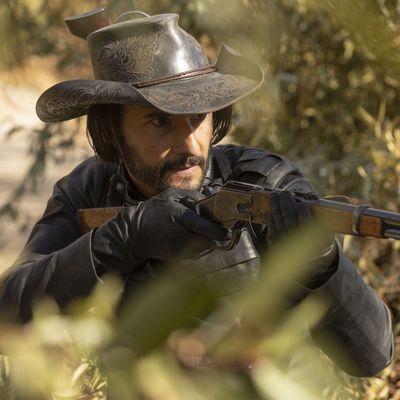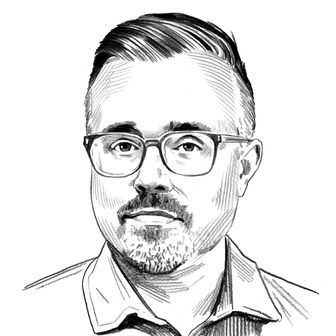
Spoilers below for Westworld’s season-two finale. You’ve been warned!
We’ve come mighty far since those simple days of black hats and white hats in the sleepy Western town of Sweetwater. The Westworld second-season finale, “The Passenger,” is a game changer of an episode, killing a ton of major characters while also revealing something truly stunning: In a world where human behavior is as predictable and easily replicated as coded androids, death is no longer an absolute for anyone. Of course, a finale like this one leaves quite a few major questions lingering for season three. Here’s what we’ll be pondering until Westworld returns.
Who is *really* dead?
There’s a tremendous amount of bloodshed in the season finale, but how long will any of these deaths actually last? Think about it: Dolores, Bernard, and Charlotte are technically all shot to death, yet they end the finale alive and together in Arnold’s house. So, can we really count on anyone being gone for good? Will we see Maeve, Hector, and the gang again? And what about Clementine? It’s certainly possible, since Tom and Sylvester are ordered to “salvage” any viable hosts they find on the beach.
Yes, a few of the human characters like Elsie, Sizemore, and Strand may not return in season three, but frankly, anything is possible given how life and death wrap around each other in this finale. If we’re going by gut instinct, though, one departure does feel different than the rest: When Bernard says good-bye to his memory of Ford, it feels like a permanent farewell and a grandiose send-off for Anthony Hopkins.
What the heck happens in that post-credits scene?
Wait, did you know there was a post-credits scene? If you didn’t stick around, you missed something major: A gravely injured William makes it down to a Forge that looks damaged but also vacant, leading to the question of when exactly this scene is taking place. (And also where, if you consider how many scenes in Westworld are actually simulations of the real world.). We last saw William in a tent on the beach, injured but clearly still alive. Is this scene set before or after that moment? Or could it be set in a simulation? William’s eyes are closed when we see him on the beach, so could this even be a dream?
Whenever or wherever it takes place, William encounters what appears to be a host version of his daughter Emily, who promises him that it isn’t a simulation — “This is your world. Or what’s left of it,” — and then ushers him into a room like the one where he spent years testing James Delos. She reveals that they’ve been testing him for “a long time,” but now they’re almost done checking him for “fidelity.” Sound familiar? This seems to all but confirm what so many fans have suspected all season: that William is actually a host version of the real man. It’s one hell of a cliff-hanger.
Is Stubbs a host?
The scene on the beach between Stubbs and Dolores is a fascinating one. Stubbs references being loyal to Ford, what “Ford gave me,” and his “core drive,” all before saying he’s only responsible for hosts inside the park. There’s recognition in his eyes: His test clearly revealed that she’s not the real Charlotte, and yet he’s deciding to let a host go free anyway. But does all that talk of his role and core drive mean that Stubbs is himself a host? And if so, did Ford program him to let Dolores escape? It might be a long shot, but stranger things have happened on Westworld.
Has Westworld ever shown us the real world?
When Dolores and Bernard enter the Forge in search of the true system underneath, they find it at a recreation of James Delos’s retirement party: The “system” has taken on the persona of Logan Delos, as reconstructed by his father’s memories. But if the system can recreate memories so precisely, how many sequences from the “real” world have we actually seen this season? It doesn’t seem coincidental that one the season’s first major scenes took place at that party, when Dolores stumbled across a drug-addled Logan. Was that a simulation or a memory? If you fall deep enough down the rabbit hole of Westworld, you may ask yourself: What’s the difference? If the Forge is designed to replicate memories, does it matter if we’re watching the real thing or a simulation? Ow, my head hurts a little bit.
Does an inevitable moment define every person’s life?
This question is a heady one, but it’s definitely worth considering. In a fascinating sequence, the “system” explains that it worked millions of possible paths for James Delos, but they all arrived at the same point: The dismissal of his son when he truly needed him. The thematic depth of this scene is two-fold: It suggests that free will is something of a myth, and that certain inevitable moments are what define who we truly are. This is the philosophical undercurrent of the show: If every iteration of Delos pushes his son away, does every iteration of Dolores escape the island? Does every iteration of Maeve save her daughter? And on and on. Ford is presented as the architect of everything that’s happened on Westworld, but this episode takes that God-like concept a step further, implying that everyone, hosts and humans alike, has a scripted narrative that they can’t avoid.
What did Dolores steal from the park?
As she speeds away on a boat, Dolores/Charlotte looks at five control units in her bag. Who exactly did she save? The exact information in those little spheres isn’t clear, but we’ve seen how much data can be stored in just one, based on what Peter Abernathy was carrying around in his head. Did Dolores get enough data off of the island to completely rebuild the host population? (She mentions that some were “left behind,” and then the scene cuts to Teddy in the Valley Beyond, so does that mean she left him there?) Did she take the guest data as well? If so, what does she plan to do with it?
How long has Dolores been tweaking Bernard? And did Ford program her to do it?
This is a fascinating question to consider. We learn that Dolores was tasked with testing Bernard in the Cradle simulation to get him as close as possible to Arnold, but that she began to tweak his behavior to fit her own needs after thousands and thousands of attempts. Or did she? Is this actually part of Ford’s narrative too? Perhaps he programmed Dolores to alter Bernard ever so slightly, in a way that felt like free will to her. Or did the simulated Dolores within the Cradle gain free will before her revolution even began? Call it a hunch, but it feels like this twist has Ford’s fingerprints all over it.
Where the heck do we go from here?
As the season ends, Bernard opens the door to leave Arnold’s house, looks around for a moment. and then cracks a smile before stepping through the threshold. What exactly does he see? Is it his family? A rebuilt Sweetwater? The surface of the moon? Who knows. Although the season finale reveals a lot about the show’s philosophy, it also left open a bunch of new mysteries for season three. Until Westworld returns, we’ll just have to ask ourselves the biggest question of all: Where do you think the show will go next?


